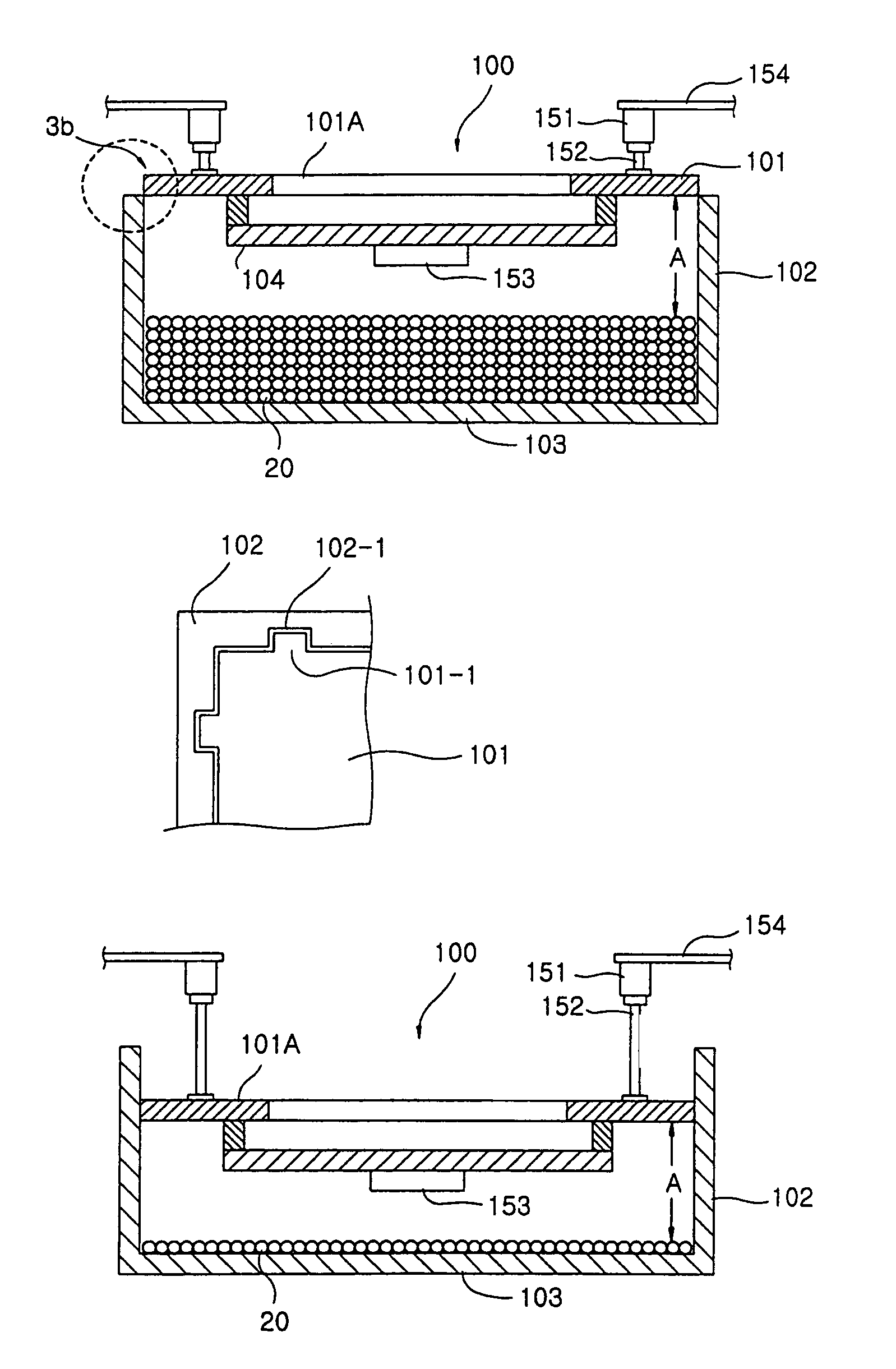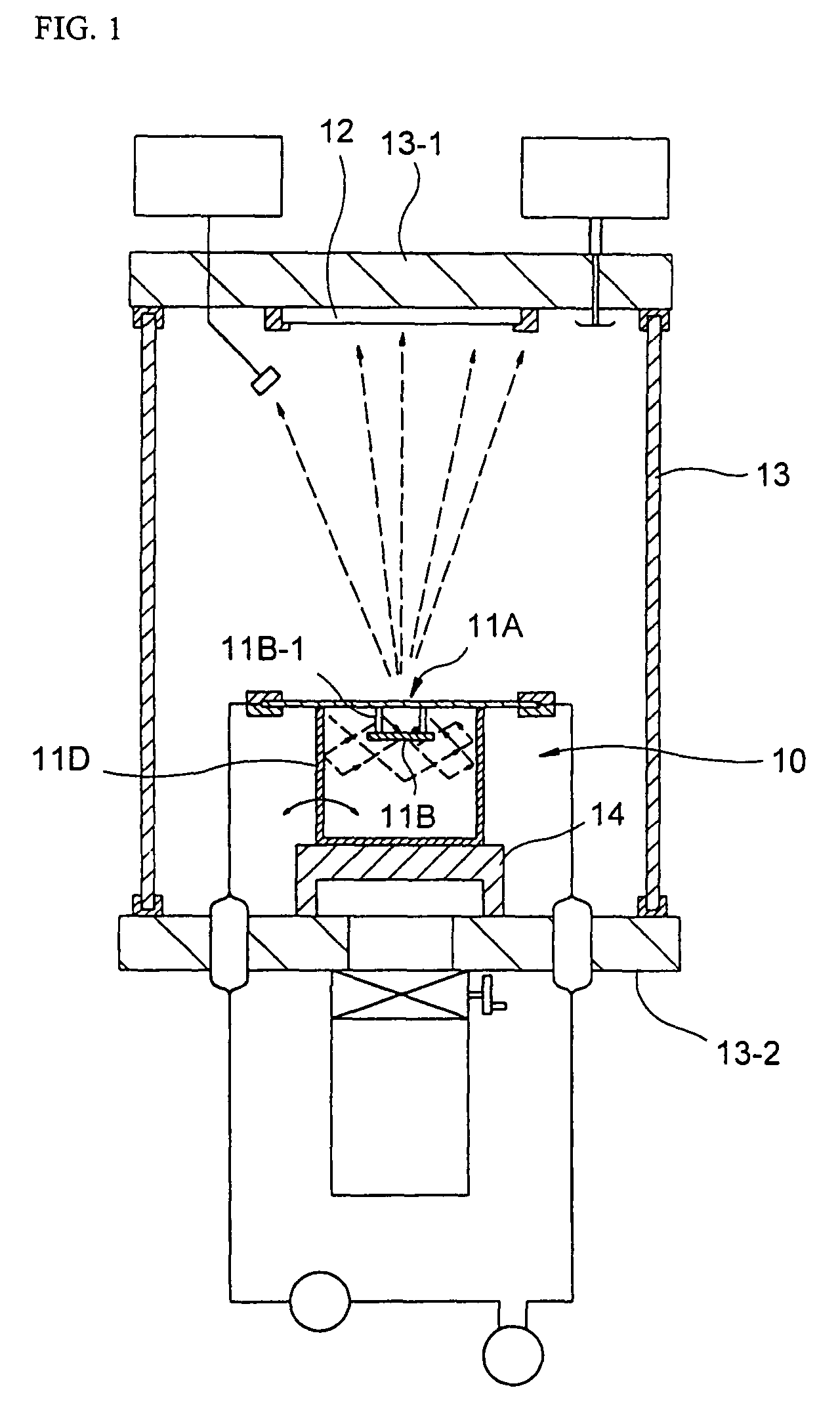Source for thermal physical vapor deposition of organic electroluminescent layers
a technology of thermal physical vapor and electroluminescent layers, which is applied in the direction of vacuum evaporation coating, sublimation, and separation processes to achieve the effect of avoiding decomposition, and ensuring the quality of the electroluminescent layer
- Summary
- Abstract
- Description
- Claims
- Application Information
AI Technical Summary
Benefits of technology
Problems solved by technology
Method used
Image
Examples
first embodiment
[0041
[0042]FIG. 3a is a sectional view of the deposition source according to the first embodiment of the present invention. A deposition source 100 according to the first embodiment is a vessel consisted of a top plate 101, a side wall 102, and a bottom wall 103. The deposition source 100 contains solid organic electroluminescent vapor deposition material 20 (hereinafter, referred to as “deposition material”). A vapor efflux aperture 11A is formed on the top plate 101. The function of the vapor efflux aperture 101A is to discharge vapor of vaporized deposition material from the deposition source 100. A baffle member 104 fixed to a lower surface of the top plate 101 corresponds to the efflux aperture 101A.
[0043]The top plate 101 can act as a heating means (heater) for supplying heat to the deposition material 20 or a separate heating means can be placed on (or below) the top plate 101. In the description below, a case where the top plate 101 acts as a heating means will be explained ...
second embodiment
[0056
[0057]FIG. 4 is a sectional view of the deposition source according to the second embodiment of the present invention. The entire structure of a deposition source 200 according to this embodiment is the same as that of the deposition source 100 shown in FIG. 3a and FIG. 3c. In this embodiment, a top plate 201 can act as a heating means (heater) for supplying heat to the deposition material 20 or a separate heating means can be placed on (or below) the top plate 201. In the description below, a case where the top plate 201 acts as a heating means will be explained as an example.
[0058]The most important feature of the deposition source 200 according to the second embodiment is that a bottom plate 203 can be moved vertically in response to change of the distance between the surface of the deposition material 20 and the top plate 201.
[0059]As described above, the uniformity of the deposition layer to be formed on the surface of the substrate (12 in FIG. 1) depends on change of the ...
third embodiment
[0073
[0074]FIG. 5 is a sectional view of the deposition source according to the third embodiment of the present invention. The deposition source 300 according to this embodiment has a vessel consisted of a top plate 301 acting as the heating means, a side wall 302, and a bottom wall 303. The structure of the top plate 301, on which a vapor efflux aperture 301A is formed and to which a baffle member 304 is fixed, is the same as the top plates 101 and 201 of the deposition sources 100 and 200 of the first and second embodiments, respectively. Therefore, a further detailed description thereon is omitted.
[0075]The important aspect of the deposition source 300 shown in FIG. 5 is that a number of coils C1, C2, . . . Cn as a heating means for transferring heat to the deposition material 20 are wound around the side wall 302, and a casing 350 is located at the outer side of the side wall 302.
[0076]A number of coils C1, C2, . . . Cn are wound on the outer circumference surface of the side wa...
PUM
| Property | Measurement | Unit |
|---|---|---|
| surface area | aaaaa | aaaaa |
| deposition | aaaaa | aaaaa |
| pressure | aaaaa | aaaaa |
Abstract
Description
Claims
Application Information
 Login to View More
Login to View More - R&D
- Intellectual Property
- Life Sciences
- Materials
- Tech Scout
- Unparalleled Data Quality
- Higher Quality Content
- 60% Fewer Hallucinations
Browse by: Latest US Patents, China's latest patents, Technical Efficacy Thesaurus, Application Domain, Technology Topic, Popular Technical Reports.
© 2025 PatSnap. All rights reserved.Legal|Privacy policy|Modern Slavery Act Transparency Statement|Sitemap|About US| Contact US: help@patsnap.com



